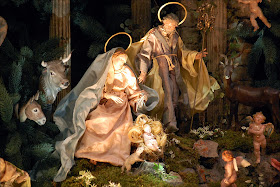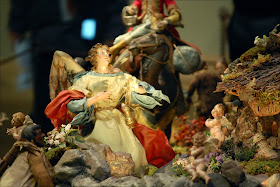 |
| Nonna Isolina and Grandpa Rissolo's wedding |
By Cookie Curci
It’s a fine line drawn by our parents and grandparents, in the lessons that teach us independence while at the same time anchoring us with their love. These stories and family histories are a guidepost for each generation, filled with the successes and dreams of our parents and grandparents, the words have a power all their own. Their stories remain with us a lifetime, they stay in our heart and, more importantly, in our attitude towards life.
They say the two best things you can give children are roots and wings, to this I add grandmother’s, women who help shape our lives with their opinions, their beliefs and their love and whose indelible memories stay with us a lifetime….
CHRISTMAS COFFEE WITH NONNA.... There are times in our lives when we think all that's good or exciting has passed us by- that we may have missed out on that one big chance or golden opportunity that would have changed our lives for the better.
That's how I was feeling the day I paid my Grandma Isolina a long overdue visit.
Nonna was well into her 90s when her gentle wisdom and intuitive powers helped redirect my life. I learned from her that we all have the capability to restart our lives or to help others renew their own.
For me, it happened at that magical time of the year when Christmas touches our hearts and childhood memories call us home again.
 It was Christmas time and all around me people were busily anticipating the holiday season. Decorations glittered in department store windows; a jovial Santa Claus sat merrily in every shopping mall. Everywhere I looked, I saw happy couples walking arm- and- arm anticipating the holiday.
It was Christmas time and all around me people were busily anticipating the holiday season. Decorations glittered in department store windows; a jovial Santa Claus sat merrily in every shopping mall. Everywhere I looked, I saw happy couples walking arm- and- arm anticipating the holiday.
As for myself, I was in no mood for celebration. At age 45, I'd lost my job, and was facing the fact that none of my lifelong plans and dreams were ever going to materialize. That year, I firmly decided not to celebrate Christmas.
For over 25 years, I'd put my dreams of becoming a writer on hold while I worked for a more lucrative pay as a receptionist. My job offered little creative outlet, but more importantly, it kept the bills paid. And now it was gone. I'd also put off getting married, so now here I was in my mid 40s, without a job, and without a Mr. Right.
I was deep in the doldrums when my phone rang. It was an unexpected call from my Nonna Isolina asking me to spend the holiday with her. Hearing my Nonna's voice with her familiar Italian accent comforted me and sparked happy memories.
As a lot of things I'd planned, but never found time to do, visiting Nonna was high on the list. But the longer I put it off the harder it was to do.
 |
Nonna Isolina and
Grandpa Rissolo with mom |
I wanted to remember Nonna as she once was—a robust, happy-go-lucky, robust woman, who inspired me with her deep beliefs and intrigued me with her tales of the old country. More importantly, I wanted Nonna to remember me as I used to be—young, innocent and full of ambitious dreams.
For a moment, I tried to think of a good reason to turn down Grandma's generous invitation. I wanted to keep my memories of her as she was, the sound of her vibrant voice, the reassurance of her gentle touch and that approving twinkle in her eyes that seemed to shine there just for me; and how our laughter would fill her kitchen long into the night as we sat talking and planning the future.
I was painfully aware that none of the plans we'd made for my life were going to come true. I guess I was afraid of seeing the disappointment in Nonna's eyes. Nevertheless, I knew in my heart I couldn't refuse her invitation; that night I drove the long miles to Nonna's house, back to the home of my childhood, to its cracks and creeks and timeless charm.
What would my visit bring?
I had to knock several times before Nonna finally came to the door. Standing all alone in the doorway, she appeared fragile and much older than I remembered, but her eyes still twinkled with that same vibrant warmth of welcome.
"Come in, come in, Bella mia," she said, using her best broken English. The words mean "My beautiful," and Nonna was the only one who could still make me feel beautiful.
Nonna led me down the hall to her cozy, familiar kitchen. She sat me in Grandpa's big empty armchair at the head of the table. I remembered that table well, and all the many wonderful family suppers we'd enjoyed there on Sundays and holidays.
I was greeted by the sweet smell of anise cookies baking in the oven and the aroma of Nonna's simmering coffee pot on the stove. Mingled with the fresh scent of evergreen it painted a vivid picture of Christmases past. It was a sensory mix of flavors and feelings that is, to this day, impossible to replicate. Assembled on the wall was a collection of baby pictures, and childhood milestones. Remnants and pictures of my baptism, my First Holy Communion, and Confirmation. Family snapshots filled her walls.
Everywhere I looked, I saw a part of my past in her treasured keepsakes. I sat on the window seat where I used to huddle on wintry afternoons to watch the rain trickle down the windowpanes. In the spring, I looked through that same window at Nonna's garden where hollyhocks ascended like skyscrapers and stout sunflowers stood like golden bastions against the wind. And, I recalled how the smell of her coffee pot, eternally simmering on the stove, gave me a feeling of well-being.
Nonna's aged cat, Chulet, was still at her feet, trailing behind her as she shuffled from room to room. I remembered the old cat and how it was once a spry young kitten chasing butterflies that thronged to Nonna's vegetable garden. Nonna and I were younger then too.
In the corner of the room stood a spindly Christmas tree filled with ornaments made by her grandchildren, who had all grown-up now and moved away. Though they were gone, I could feel that a part of them would always remain there for Nonna—in those humble objects. Like a golden talisman each ornament held a cherished place in her memory.
 |
| Cherished Christmas memories |
Glowing beneath the evergreen was Nonna's beloved, albeit, timeworn nativity scene. The plaster of Paris figurines had been under her tree for as far back as any of us could remember. Each of her grandchildren were responsible for every chip and nick on the tattered set of figurines.
But somehow they managed to retain their original charm and were as beguiling to me now as the very first day she'd placed them under the tree.
Before I knew it, I was captivated by Nonna's old-world charm. My old hopes and dreams were suddenly resurrected, along with my faith in the Christmas spirit.
I watched Nonna's time-worn hands trembling slightly as she poured me a cup of her hot, strong coffee. Soon we were sipping coffee and dunking sweet anise cookies just as we'd done so many years ago. Chatting away like schoolgirls, the sound of our voices filled Nonna's kitchen. While the enduring elements of laughter and love inspired me, the years seemed to melt away. With each memory came renewed desire. Grandma's relentless words of encouragement had given me new inspiration.
I spent that Christmas Eve talking long into the night with Nonna.
She predicted that I'd soon find a new job as a writer and with a little more patients and faith in myself; I'd also find my Mr. Right. I snickered at Nonna's predictions. I reminded her that I was over forty now and not the young, impressionable girl who used to sit upon her knee.
Nonna's brow furrowed as her jaw set firmly into a frown. A moment later she was cradling me in her fragile arms cajoling me while at the same time tenderly scolding me for not having faith in her predictions and faith in myself.
"Bella Mia, she said, "You're not listening with your heart, how can you be successful, if you don't believe in yourself with all your heart?"
She was right of course. I had to learn to believe in life again, and more importantly in myself. I took Nonna's advice and spent all that week listening and believing. I took endless notes as she told and retold stories of her life in the old country, of her family histories and humorous anecdotes of her arrival in America. As I recorded page after page of Nonna's colorful memories, the aroma of her simmering coffee pot warmed the atmosphere.
That year, Nonna persuaded me to return home and upon her urgings I continued writing. I submitted some of my stories to my community newspaper. My grandmother’s nostalgic family stories were so well received, I was offered my own ongoing column.
That was 15 years ago. Since that time I've been writing my column for several community and national newspapers. Grandma's stories were also published in several Chicken Soup For the Soul books as well as other national book publications, newspapers and magazines.
Just as my insightful Nonna had predicted, my Christmas wishes came true. Believing in myself had something to do with it, but her belief in me had everything to do with it. My success brought me a new career, as well as a new man in my life. I found my Mr. Right and married the following year.
Sadly, my Nonna wasn't here to see all of her predictions come true. But somehow I know on that last Christmas visit with her, that she knew in her infinite wisdom exactly what the future held in store for me and that she will always be an important and indelible part of my life.
I learned from grandma that family ties connect us to one another and that these ties lengthen and grow to accommodate change, distance and time- and in that way they are never broken.
These bits and pieces of my past remain as real and genuine to me now as Nonna's aluminum coffee pot that today sits upon my stove. And as long as I go on making coffee with that same old shiny pot, in a way, I'm still having coffee with Nonna.






























































